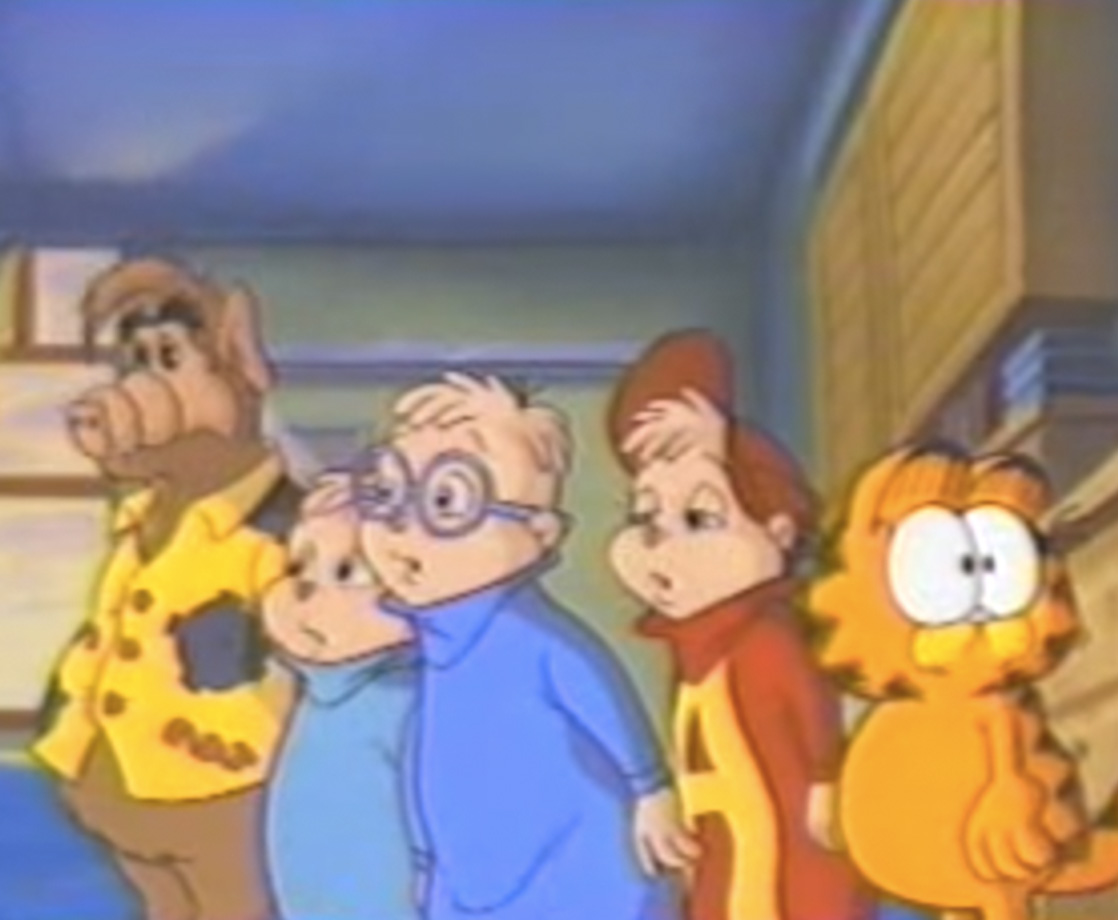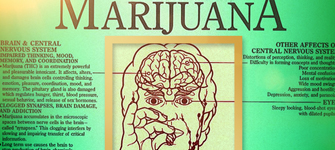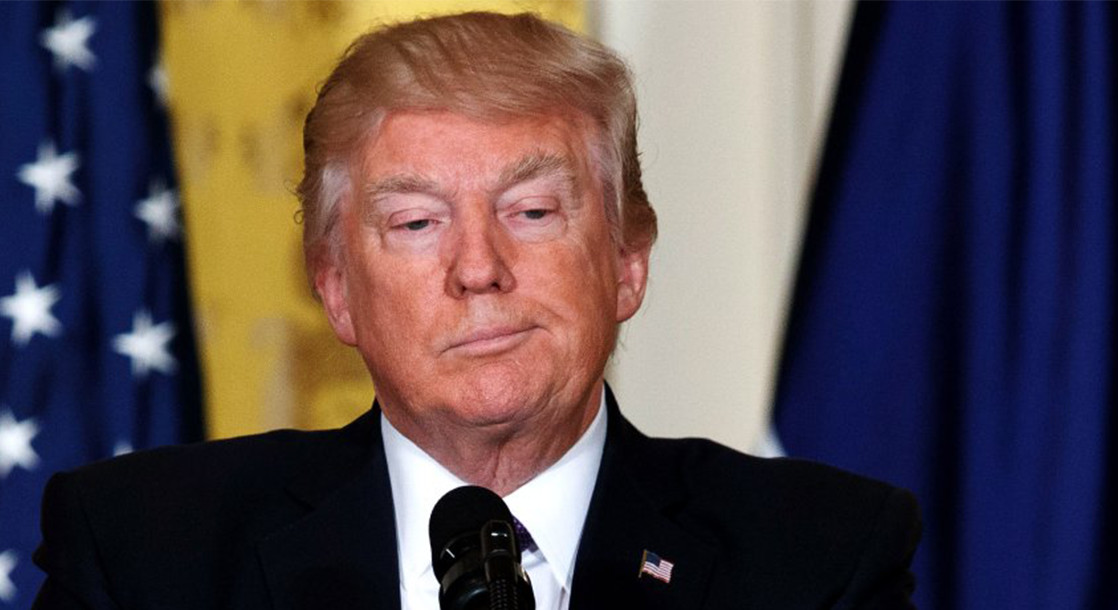1990’s Cartoon All-Stars to the Rescue is something like the “We Are The World” of animated propaganda films. Watching a plethora of animated characters across multiple universes and property rights come together in an effort to help guide a wayward teen away from the darkside of drugs and back towards the light is about as humanitarian an effort as we’re likely to witness in the annals of the anti-drug propaganda canon.
The animated film, which mixes the life-spanning narrative of A Christmas Carol with the on-screen assemblage of The Avengers, opens with an intro by then-President George H. W. Bush and First Lady Barbara Bush, who urge viewers to start a conversation with friends and family after watching the program. First Lady Barbara spends the entire effort petting their dog Millie, looking a bit more like a supervillain than a concerned citizen, but no matter as we quickly fade out from the White House and into the bedroom of a youngster named Corey.
We see a mysterious hand reaching into a bedroom and snatching a piggy bank. Just then, the camera zooms into the pages of a comic book laying on the floor, the breeze from an open window shuffling the pages and bringing us into The Smurf village. Papa Smurf awakens and notices the missing piggy bank, which I guess looms over the pages of the comic book and above the skyline of Smurf village, proving that not even the Smurfs are immune from the oppressive visual presence of capitalism.
The Smurfs quickly jump out of the page, catapulting a number of other famous, animated characters to come to life, including Alf who exits a picture frame and helps the group try and figure out where Corey’s piggy bank went — though why Corey has a framed headshot of Alf in her bedroom goes undiscussed. Alf goes and wakes up Garfield, who is the living embodiment of “blazed,” who then gathers Alvin and the Chipmunks and Winnie the Pooh to investigate. In an act of emotional terrorism, they leave the grotesque Ghostbusters ghost to be floating bedside to deliver the bad news to Corey.
Corey eventually catches her brother, Mikey, going through the coins out of her broken piggy bank, a betrayal of the highest order. He’s acting different, his eyes are red, he shoves a mysterious box under the bed, and unknowingly into the hands of the Chipmunks who are hiding out and listening to the entire confrontation.

What we learn is that Mikey has fallen prey to the most insidious force of all: peer pressure. His friend group has quietly bullied him into dabbling with drugs, and now the dude is full-on addicted and running away from the police. (Note: Mikey went from “dabbler” to “addict” in less time than it takes to watch this whole PSA). It turns out he has his own little animated sidekick: a purple, ghoulish spirit, most accurately read to be the essence of drug addiction. As he’s chased by the cops, Mikey reaches a dead end in the alleyway, and begins to plead with the approaching officer, who is suddenly revealed to be none other than ya boy Bugs Bunny.
The PSA then goes into a tailspin when Bugs and Mikey enter a time machine, which really loses its punch after Bugs declares they’re going all the way back to “two years ago.” From there, the movie delves into a blend of ‘70s psychedelia and ‘80s moral goodness, with the cartoon characters taking Mikey into the corridors of his own brain. There, he sees himself in a hall of mirrors, each manipulating the contours of his face and body so he resembles a gaunt addict (though the illustrations never get too grotesque, instead depicting him as if he were seasick or has food poisoning).

Cartoon All-Stars To The Rescue is, objectively, a pandering piece of anti-drug propaganda, but it’s also arguably one of the campaign’s most important. Released on April 21, 1990 — whether it consciously meant to orbit 4/20 is unclear — the film was hyped and heavily promoted event television for the Saturday morning cartoon set. It remains the single largest anti-drug PSA effort in history, and has the noble distinction of being the first ever scripted program to air simultaneously across all four major networks: ABC, NBC, CBS, and FOX.
In January of 1990, President Bush approved a 50% increase in military spending as related to the War On Drugs, specifically focusing on the influx of criminal activity in Nicaragua and Columbia. At home, the war was being waged on a much smaller turf, though with no less a financial push. This spot was one of many funded by none-other than McDonalds, an early corporate partner in the war on drugs. It cost millions of dollars to make, though allegedly the licensing fees of the properties used were willingly waived, making this one of the first and only times that characters across multiple different franchise properties appeared in a single work together.

“This kid’s got a one way ticket to nowheresville,” Alf says, watching as Mikey leans further and further into the annals of drug use. This image works twofold: it allows kids to, perhaps, better digest the lesson of drug use by having it come through the mouth of a cartoon they’ve grown to care about. But there is also the notion that these figures have become authorities of a certain type of value, and that their disappointment means something. At a certain point, even a Teenage Mutant Ninja Turtle manages to make a cameo and pitch a message.
The image of this kind of capitalist harmony goes a longer way to making an impact than any of the cartoon’s actual content. It is truly an American notion, to lean onto the talisman of corporate sponsorships in an effort to clean the country up. In a way, Cartoon All-Stars is most meaningful as an example of this twisted conflation of American values and American icons. Its most meaningful content comes rather symbolically, watching cartoon characters essentially try and revive a young child’s innocence.
By the end of the film, after touring his past, his present, and even the corridors of his own brain, Mikey snaps out of it when he sees the Purple Smoke trying to lure Corey into drugs as well. The film ends with a musical number, “Wonderful Ways To Say No,” written by Academy Award winner Alan Menken and Howard Ashman, most beloved for their work in The Little Mermaid and Aladdin. My personal favorite “way to say no” is definitely, “just say you’re allergic!” an excuse I’ll be using anytime I’m confronted with drugs, working out, working in general.

Less than a year before this PSA came out, President Bush delivered one of the most definitive speeches of his presidency, when he held up a bag of crack he claimed had been purchased at a park directly across from the White House. The situation had been, we would later discover, a bit of a set up: a dealer was coerced into coming to the park in an effort to buy the drug in proximity to the White House for dramatic effect (the dealer, it’s said, did not even know where the White House was). Thus, the escalation in the War On Drugs under Bush’s tenure began, where he pledged $1 billion dollars in the effort to stop the drug epidemic. “We need more jails, more prisons, more courts, and more prosecutors,” he said.
Cartoon All-Stars seems an unlikely example of this bold step forward, but within the framework of how intellectual property works in this country, it’s a power move. These are characters that have never before shared a screen together, largely because corporate interest places them in direct competition with each other. “The enemy of my enemy is my friend” seems to apply to fictionalized cartoon characters, too, as the project manages to embody both the best and the worst of American popular culture: positive influence via corporate manipulation, which is really scary when you come to think of it.

In one of the final scenes, Alf drags Mikey to an office door marked “The Man In Charge,” in an effort to show him that while he thinks he is responsible for his own actions, the perils of drug addiction will always overtake freewill. When he enters the room, the back of the boss’s chair is facing us, concealing The Man’s identity. When the chair turns around, he’s greeted by — no surprise — the fucking purple smoke. It’s a reveal meant to tell you that before you know it, you take drugs and then drugs overtake you. But the message is influence; we’ll do whatever we’re told to. What if it behooved Bush Sr. to push the drug agenda for reasons that had nothing to do with us? What if these same cartoons were used for more insidious motives? Manipulated to telegraph a different message, effective because of their familiarity. The Man In Charge will always be whatever bares the most influence, with or without drugs. Alf walks Mikey into that room, and Alf could’ve been sitting in that chair.
Follow Rod on Twitter











